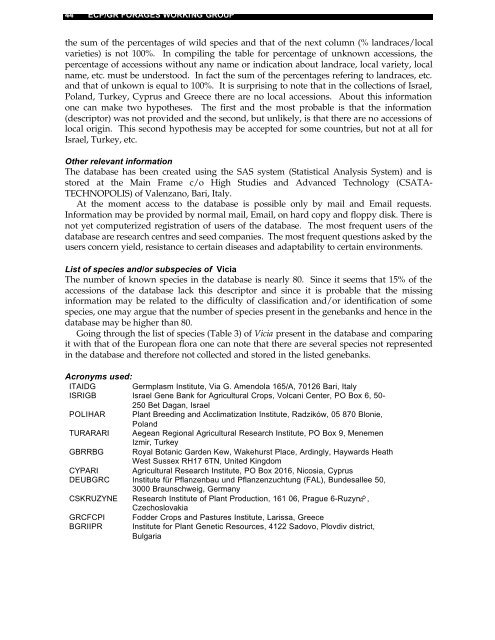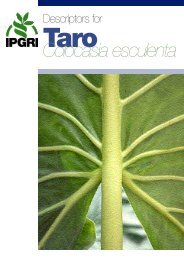Download PDF (6215 kb) - Bioversity International
Download PDF (6215 kb) - Bioversity International
Download PDF (6215 kb) - Bioversity International
Create successful ePaper yourself
Turn your PDF publications into a flip-book with our unique Google optimized e-Paper software.
44<br />
ECP/GR FORAGES WORKING GROUP<br />
the sum of the percentages of wild species and that of the next column (% landraces/local<br />
varieties) is not 100%. In compiling the table for percentage of unknown accessions, the<br />
percentage of accessions without any name or indication about landrace, local variety, local<br />
name, etc. must be understood. In fact the sum of the percentages refering to landraces, etc.<br />
and that of unkown is equal to 100%. It is surprising to note that in the collections of Israel,<br />
Poland, Turkey, Cyprus and Greece there are no local accessions. About this information<br />
one can make two hypotheses. The first and the most probable is that the information<br />
(descriptor) was not provided and the second, but unlikely, is that there are no accessions of<br />
local origin. This second hypothesis may be accepted for some countries, but not at all for<br />
Israel, Turkey, etc.<br />
Other relevant information<br />
The database has been created using the SAS system (Statistical Analysis System) and is<br />
stored at the Main Frame c/o High Studies and Advanced Technology (CSATA-<br />
TECHNOPOLIS) of Valenzano, Bari, Italy.<br />
At the moment access to the database is possible only by mail and Email requests.<br />
Information may be provided by normal mail, Email, on hard copy and floppy disk. There is<br />
not yet computerized registration of users of the database. The most frequent users of the<br />
database are research centres and seed companies. The most frequent questions asked by the<br />
users concern yield, resistance to certain diseases and adaptability to certain environments.<br />
List of species and/or subspecies of Vicia<br />
The number of known species in the database is nearly 80. Since it seems that 15% of the<br />
accessions of the database lack this descriptor and since it is probable that the missing<br />
information may be related to the difficulty of classification and/or identification of some<br />
species, one may argue that the number of species present in the genebanks and hence in the<br />
database may be higher than 80.<br />
Going through the list of species (Table 3) of Vicia present in the database and comparing<br />
it with that of the European flora one can note that there are several species not represented<br />
in the database and therefore not collected and stored in the listed genebanks.<br />
Acronyms used:<br />
ITAIDG Germplasm Institute, Via G. Amendola 165/A, 70126 Bari, Italy<br />
ISRIGB Israel Gene Bank for Agricultural Crops, Volcani Center, PO Box 6, 50-<br />
250 Bet Dagan, Israel<br />
POLIHAR Plant Breeding and Acclimatization Institute, Radzików, 05 870 Blonie,<br />
Poland<br />
TURARARI Aegean Regional Agricultural Research Institute, PO Box 9, Menemen<br />
Izmir, Turkey<br />
GBRRBG Royal Botanic Garden Kew, Wakehurst Place, Ardingly, Haywards Heath<br />
West Sussex RH17 6TN, United Kingdom<br />
CYPARI Agricultural Research Institute, PO Box 2016, Nicosia, Cyprus<br />
DEUBGRC Institute für Pflanzenbau und Pflanzenzuchtung (FAL), Bundesallee 50,<br />
3000 Braunschweig, Germany<br />
CSKRUZYNE Research Institute of Plant Production, 161 06, Prague 6-Ruzyn,<br />
Czechoslovakia<br />
GRCFCPI Fodder Crops and Pastures Institute, Larissa, Greece<br />
BGRIIPR Institute for Plant Genetic Resources, 4122 Sadovo, Plovdiv district,<br />
Bulgaria




